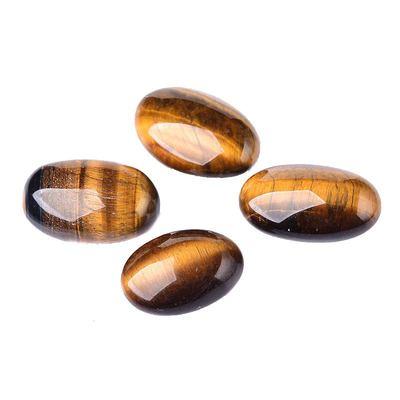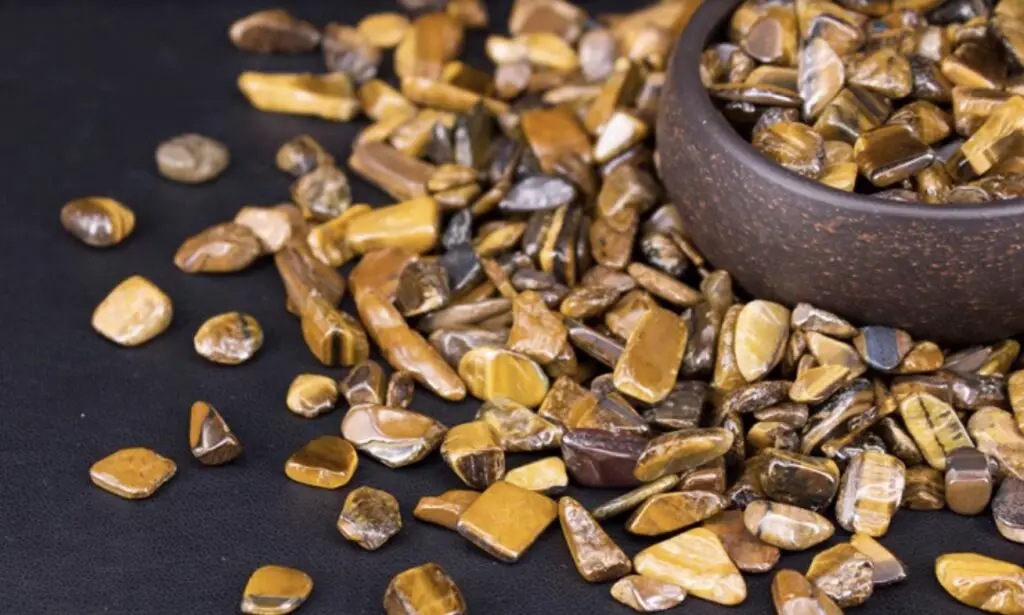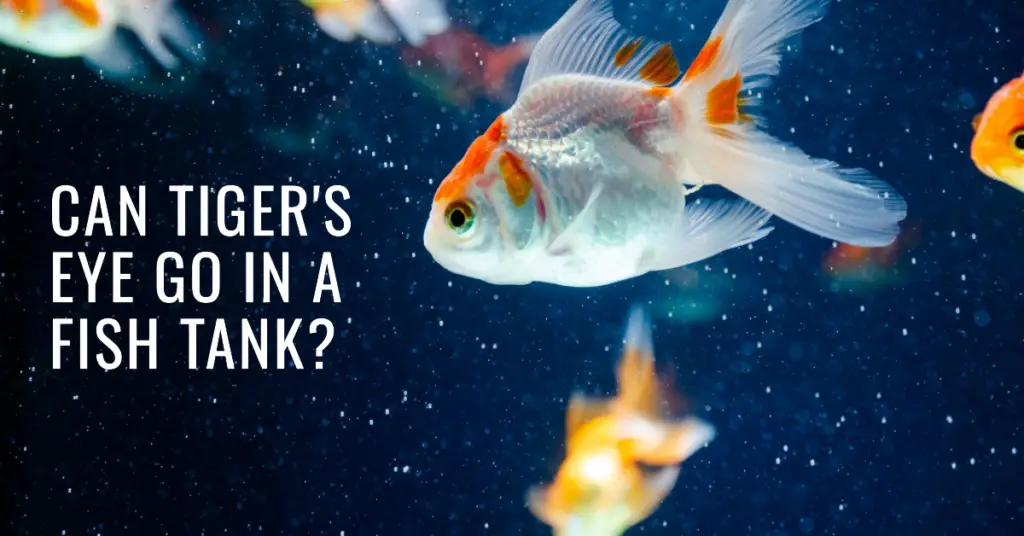Tiger’s Eye is a popular gemstone commonly used in jewelry and spiritual practices. Its rich golden brown color and sparkling bands of fibers make it an aesthetically pleasing choice for many decorative pieces. This has led some aquarium owners to wonder – can I place tiger’s eye stones in my fish tank for decoration?
Generally speaking, tiger’s eye stone is safe to put in your fish tank and will not be toxic to your fish. However, tiger’s eye rock has some special properties, so there are some potential risks and drawbacks to be aware of. Let’s take an in-depth look at how tiger’s eye stone can affect the habitat of your fish tank.
Considering Tiger’s Eye as Aquarium Décor
At first glance, tiger’s eye stone can indeed be an attractive decoration for a fish tank. Its golden luster and stone-like nature can mimic the natural material found at the bottom of a stream or river. Against gravel, plants or a natural background, the visual interest and color of tiger’s eye stone will stand out.
Additionally, tiger’s eye is often considered a durable material that is not easily scratched or broken. This durability makes sense for high-traffic aquarium environments. The gemstone also has a smooth polished surface that minimizes the risk of injury to fish.
Aesthetic Appeal in an Aquascape
One of the main reasons hobbyists use rocks, stones or pebbles in their aquariums is for aesthetic reasons. Aquarium aquascaping artfully pairs hard materials with plants, wood and other elements. This is done to create a stunning natural environment for fish.
Tiger’s Eye matches the visual character of the materials used. Its warm golden tones can complement the green color of the plants. Arranging tiger’s eye and sky-blue mineral pebbles in stark contrast can make a strong visual impact. Creative placement on the slopes, edges or bases of decorative objects can draw the eye.
Tiger’s eye stone is an affordable option for those who want the look of a specialty mineral without the high cost. Specialized aquarium aquascape stones can be expensive, while tiger’s eye stone is moderately priced. All in all, the natural beauty of tiger’s eye stone is a great idea for enhancing the style of your aquarium.

Safe material considerations
However, aesthetics alone are not enough to justify adding materials to a fish tank. Any ingredient that goes into the tank must be safe for the fish. Tiger’s Eye appears to be an inert, non-toxic mineral that is unlikely to degrade water quality. Still, it is wise to verify its safety.
Certain types of rocks can leach minerals or metals over time, which can alter the chemical composition of the water. Inert materials such as quartz or obsidian are often appropriate choices when evaluating gemstones for use. Tiger’s eye belongs to the quartz family and therefore falls into this category.
Additionally, tiger’s eye has a Mohs hardness rating of 7, which means it can withstand scratches and everyday wear and tear. Durability is crucial so that decorative items don’t quickly break down or wear out after being submerged in water. Overall, tiger’s eye stone meets the strength and stability needed in an aquarium environment.
Precautions for placing tiger’s eye stones in aquariums
While tiger’s eye stone may seem aesthetically pleasing and safe at first glance, there are still several factors to consider before using it in an aquarium. The composition, structure, shape and placement of the tiger’s eye stone will affect its function.
Chemical Composition Concerns
As mentioned earlier, tiger’s eye, like other quartz materials, is primarily composed of silica. However, some tiger’s eye stones may also naturally contain small amounts of asbestos fibers. Crocidolite or bluish asbestos can seep between the quartz fibers, creating a showy effect.
The good thing is that these ingredients, if not de-processed and dust with asbestos is created, are generally not harmful to fish.
However, some merchants may add other chemicals such as coatings or dyes to make the color of the tiger’s eye stone more beautiful. These chemicals may harm the fish.
Shape Considerations
Some raw stones may have jagged rough edges, which is possible to tear fins or injure fish. Any tiger’s eye stone placed in the tank should be rounded and smooth. Tumbled stones are ideal, but other shapes can be used if they are thoroughly polished.
Placement and Purpose
Where and how the tiger’s eye stone is placed is also important. Larger flat-backed stones can support a sloping sculpture or divide an open space. However, small, loose pebbles can move easily, increasing the risk of fish injury.
Consider gluing or placing large rocks in the bottom decorative layer. Also avoid clustering many small rocks together that could trap fish. Purposefully incorporate individual focal stones into the aquascape layout.

Effects on fish health and behavior
Assuming that safe, non-toxic tiger’s eye rock is used, it is unlikely to directly harm fish. However, the presence of tiger’s eye rock can still affect fish comfort, stress, and behavior. Be aware of long-term interactions between fish and tiger’s eye rock.
Novelty Stress
Any new object suddenly added to the tank will initially cause stress to the fish. The novelty may cause shy fish to hide, especially in a sparse tank. Introducing tiger’s eye stones should be done gradually, and rearranging the decor after a few days will make the transition easier.
Provide fish with adequate plant cover and alternative hiding spaces. Observe if fish such as tetra, walleye or catfish appear timid or uncomfortable. If stress persists, rocks may still be removed.
Habitat Enrichment
Also, novel distractions can benefit some active, intelligent fish. Tiger’s Eye provides new visual stimulation and space to explore. This enriched environment can curb boredom and prevent problematic behaviors.
Clusters of pebbles create interesting corners for fish such as cichlids, killifish or bettas to explore between feedings. Benthic fish such as loaches may like to explore around larger stones. Just make sure the design is not overly complicated or compact.
Tiger’s Eye, which exudes warm tones, can also have a calming effect. With its grounding and stabilizing properties, tiger’s eye stone can be a great anxiety reliever. Observe whether timid or nervous animals are relieved by the introduction of tiger’s eye stone.
Best Practices for Using Tiger’s Eye in Your Aquarium
If you choose to use tiger’s eye rock in your freshwater or saltwater aquarium, some best practices will help mitigate potential risks:
- Test the pH – Monitor the pH before and after introducing the stone to ensure that the stone does not drastically alter the chemistry of the water. Adjust pH gradually.
- Use a Polished Stone – A well-polished tiger’s eye stone minimizes crevices where debris collects and makes cleaning easier. Tumbled stones are also a good choice.
- Scrub Frequently – Clean stones during routine tank maintenance to prevent waste buildup. Use a toothbrush to remove organic material from between stone bands.
- Strategic Placement – Carefully place tiger eye stones to minimize the risk of nibbling. Keep away from feeding areas to avoid small fish mistaking tiger’s eye stones for food in the pattern.
- Limit the number – Use only one or two tiger’s eye crystals per tank to limit the toxins that may be released. Rotate different crystals to diversify the energetic impact.
- STRONG FILTER PREVENTIVE MEASURES – Take measures to prevent tiger’s eye deposits from entering the filter system, e.g. use filter wool. Regularly inspect the intake tube.
- Test for adverse effects – Observe the fish frequently after introducing tiger’s eye. If any problems are found, they should be removed immediately and not used again.
- QUARANTINE FIRST – Consider quarantining your new tiger’s eye in a bucket for 2-4 weeks. Look for any cloudiness, which may indicate the release of bacteria or a change in pH.
About the Author
I was introduced to the power of crystals by chance during a trip overseas ten years ago, and began to learn about crystals and meditation. After years of experiencing firsthand the beauty and benefits of crystals, I founded CrystalWith to share my knowledge with others.




